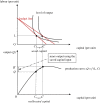The socio-economic challenges of managing pathogen evolution in agriculture
- PMID: 36744561
- PMCID: PMC9900704
- DOI: 10.1098/rstb.2022.0012
The socio-economic challenges of managing pathogen evolution in agriculture
Abstract
Genetic resistance forms the foundation of infectious disease management in crops. However, rapid pathogen evolution is causing the breakdown of resistance and threatening disease control. Recent research efforts have identified strategies for resistance gene deployment that aim to disrupt pathogen adaptation and prevent breakdown. To date, there has been limited practical uptake of such strategies. In this paper, we focus on the socio-economic challenges associated with translating applied evolutionary research into scientifically informed management strategies to control pathogen adaptation. We develop a conceptual framework for the economic valuation of resistance and demonstrate that in addition to various direct benefits, resistance delivers considerable indirect and non-market value to farmers and society. Incentives for stakeholders to engage in stewardship strategies are complicated by the uncertain timeframes associated with evolutionary processes, difficulties in assigning ownership rights to genetic resources and lack of governance. These interacting biological, socio-economic and institutional complexities suggest that resistance breakdown should be viewed as a wicked problem, with often conflicting imperatives among stakeholders and no simple cause or solution. Promoting the uptake of scientific research outcomes that address complex issues in sustainable crop disease management will require a mix of education, incentives, legislation and social change. This article is part of the theme issue 'Infectious disease ecology and evolution in a changing world'.
Keywords: agriculture; economics; evolution; integrated disease management; pathogen.
Conflict of interest statement
We declare we have no competing interests.
Figures



Similar articles
-
Modelling regional cropping patterns under scenarios of climate and socio-economic change in Hungary.Sci Total Environ. 2018 May 1;622-623:1611-1620. doi: 10.1016/j.scitotenv.2017.10.038. Epub 2017 Oct 18. Sci Total Environ. 2018. PMID: 29054621
-
The eco-evolutionary impacts of domestication and agricultural practices on wild species.Philos Trans R Soc Lond B Biol Sci. 2017 Jan 19;372(1712):20160033. doi: 10.1098/rstb.2016.0033. Philos Trans R Soc Lond B Biol Sci. 2017. PMID: 27920378 Free PMC article. Review.
-
Integrated modeling of agricultural scenarios (IMAS) to support pesticide action plans: the case of the Coulonge drinking water catchment area (SW France).Environ Sci Pollut Res Int. 2017 Mar;24(8):6923-6950. doi: 10.1007/s11356-016-7657-2. Epub 2016 Oct 10. Environ Sci Pollut Res Int. 2017. PMID: 27726081
-
Diversifying mechanisms in the on-farm evolution of crop mixtures.Mol Ecol. 2015 Jun;24(12):2937-54. doi: 10.1111/mec.13214. Epub 2015 Jun 5. Mol Ecol. 2015. PMID: 25913177
-
Assessing the value of transgenic crops.Sci Eng Ethics. 2002 Oct;8(4):497-511. doi: 10.1007/s11948-002-0003-8. Sci Eng Ethics. 2002. PMID: 12501719 Review.
Cited by
-
Infectious disease ecology and evolution in a changing world.Philos Trans R Soc Lond B Biol Sci. 2023 Mar 27;378(1873):20220002. doi: 10.1098/rstb.2022.0002. Epub 2023 Feb 6. Philos Trans R Soc Lond B Biol Sci. 2023. PMID: 36744560 Free PMC article. No abstract available.
References
Publication types
MeSH terms
LinkOut - more resources
Full Text Sources

